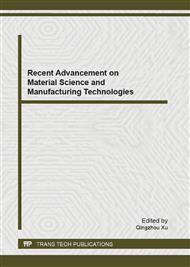p.33
p.37
p.41
p.45
p.49
p.54
p.59
p.63
p.67
Effect of Different Tempering Processes on Microstructure and Hardness of Q690 Steel
Abstract:
Q690 steel was the research object in this test. The traditional tempering and induction tempering were used in this experiment after quenching. By studying the microstructure and hardness of the sample at the two different tempering processes, it can be concluded that there are more carbide precipitations in the microstructure and the microstructure of the sample is more uniform when the tempering temperature was 450°C. For same tempering temperature, the carbide dispersion, uniformity of the microstructure and retained austenite transformation are all better in 5mm depth range to sample surface, and the hardness of the sample is lower after induction tempering. So it can be see that not only the heating up speed is faster, the energy can be saved more, but also the microstructure is more homogeneous, the mechanical property is improved greater, in a relatively short period by induction tempering rather than traditional tempering. But because of the skin effect, the microstructure distribution of the tempering layer is uneven with the increased of sample thickness, so in order to achieve the homogenizing, one of the effective methods is to improve heating affected zone according reduction the power supply frequency of induction tempering.
Info:
Periodical:
Pages:
49-53
Citation:
Online since:
July 2013
Authors:
Keywords:
Price:
Сopyright:
© 2013 Trans Tech Publications Ltd. All Rights Reserved
Share:
Citation:


